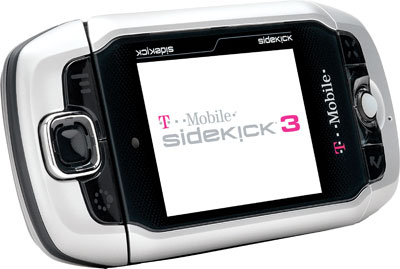Sidekick 3

Cell phones often inspire devotion, but few have a following like T-Mobile's Sidekick. The device has long been the instant messaging and e-mailing device of choice among hipsters because of its nifty flip screen and comfortable rapid-fire keyboard. But users have griped about the poor camera, crippled Web browser, and lack of expandability. The Sidekick 3 improves those areas to varying degrees and delivers Bluetooth and a smaller design. The Sidekick 3 is 20 percent smaller than its predecessor but weighs a bit more (6.7 ounces versus 6.5 ounces). The keyboard's old membrane keys have been replaced with hard plastic keys that are faster to use and more responsive.
The long rubber bumpers of the Sidekick II are gone, and the buttons within them were replaced with smaller plastic buttons. Most noticeable is the trackball, which replaces the old scroll wheel. The ball has a much looser feel but turns out to be a good navigation option. More of the device's menus can now be explored with the trackball alone, which has a 360-degree movement range and can be pressed to select items. A few tweaks improve the Danger OS: Similar applications (IM clients and organizational apps) have been grouped into single-menu items that open in subfolders. The backgrounds are darker and slightly more serious, reflecting T-Mobile's desired mid-20's demographic rather than the high school image previously associated with the phone.
As a phone, the Sidekick 3 is much improved, with better reception, stronger volume, and far less of the echo that plagued many users. While the speakerphone still sounds airy and a bit noisy, it is also noticeably improved from the last generation. The Sidekick 3 uses T-Mobile's EDGE service, and even while loading Web page images, this generation doubles the speed of the previous version. Better use of on-board memory also allows pages to load with fewer errors. Java-heavy pages stymied the Sidekick II, but this model was able to load more sites without fail. Fully zoomed-in maps were (barely) usable on Yahoo, and Google Maps proved too much to handle.
Perhaps the greatest surprise is the MP3 player, which relies on the miniSD Card slot (up to 2GB) for storage. The miniSD Card will show up in Windows as a removable drive, so you can simply drag and drop tunes into a folder. Unfortunately, the Sidekick 3 doesn't support DRM-protected tracks, so you can't use this device to play songs purchased from online music stores.
Pressing the Jump and Return keys brings up the player at any time, and music is organized by several data types, including artist, album, and playlist. The sound is good through headphones and surprisingly impressive through the phone's loudspeaker. Songs cannot be used as ringtones. As an upgrade, the Sidekick 3 could have been more dramatic. There's no question, however, that the improved phone function and data service, in addition to the miniSD Card slot and music player, make this the best model in the line yet. The Sidekick 3 is a very good smart phone option for less business-centric users.




















































